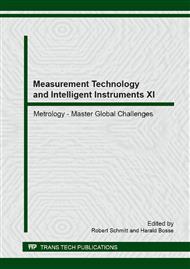[1]
Zanoni C, Differential interferometer arrangements for distance and angle measurements: principles, advantages and applications, VDI-Ber, 1989, Vol. 749, pp.93-106.
Google Scholar
[2]
Hosoe, Shigeru, Laser interferometric system for displacement measurement with high precision, Nanotechnology, 1991, Vol. 2, No. 2, p.88.
DOI: 10.1088/0957-4484/2/2/002
Google Scholar
[3]
Hosoe Shigeru. Highly precise and stable displacement-measuring laser interferometer with differential optical paths, Precision Engineering, 1995, Vol. 17, No. 4, pp.258-265.
DOI: 10.1016/0141-6359(94)00022-r
Google Scholar
[4]
Lin L, Ding W X, Brower D L, et al, Differential interferometry for measurement of density fluctuations and fluctuation-induced transport(Invited), Review of Scientific Instruments, 2010, Vol. 81, No. 10, pp. 10D509.
DOI: 10.1063/1.3464480
Google Scholar
[5]
Cheol Song, Tae Joong Kim and Gweon Dae Gab, Beam scanning confocal differential heterodyne interferometry, International Journal of Optomechatronics, 2007, No. 1, p.27–45.
DOI: 10.1080/15599610701261076
Google Scholar
[6]
Lerotic, Mirna, Finding the patterns in complex specimens by improving the acquisition and analysis of x-ray spectromicroscopy data, PhD thesis, Department of Physics and Astronomy, Stony Brook University, (2005).
Google Scholar
[7]
Moosmüller, H., and W. P. Arnott, Folded Jamin interferometer: a stable instrument for refractive-index measurements, Optics Letters, 1996, Vol. 21, No. 6, pp.438-440.
DOI: 10.1364/ol.21.000438
Google Scholar
[8]
Van Der Werf, Jan E., and Peter Dirksen, Differential interferometer system and lithographic step-and-scan apparatus provided with such a system, U.S. Patent 6, 046, 792. (2000).
Google Scholar
[9]
Cunningham, M. J., S. T. Cheng, and W. W. Clegg, A differential interferometer for scanning force microscopy, Measurement Science and Technology, 1994, Vol. 5, No. 11, p.1350.
DOI: 10.1088/0957-0233/5/11/005
Google Scholar
[10]
Schwenke Heinrich, Ulrich Neuschaefer-Rube, Tilo Pfeifer, et al, Optical methods for dimensional metrology in production engineering, CIRP Annals-Manufacturing Technology, 2002, Vol. 51, No. 2, pp.685-699.
DOI: 10.1016/s0007-8506(07)61707-7
Google Scholar
[11]
Lazar, J., Hrabina, J., Šerý, M., Klapetek, P., & Číp, O. Multiaxis interferometric displacement measurement for local probe microscopy, Central European Journal of Physics, Vol. 10, No. 1, 225-231, (2012).
DOI: 10.2478/s11534-011-0093-5
Google Scholar
[12]
Lazar, J., Číp, O., Čížek, M., Hrabina, J., Šerý, M., et. al, Multiaxis interferometric system for positioning in nanometrology, Proceedings of the 9th WSEAS international conference on Microelectronics, nanoelectronics, optoelectronics, World Scientific and Engineering Academy and Society (WSEAS), 2010, pp.92-95.
DOI: 10.2478/s11534-011-0093-5
Google Scholar
[13]
Yuan, Jie, and Xingwu Long, CCD-area-based autocollimator for precision small-angle measurement, Review of Scientific Instruments, 2003, Vol. 74, No. 3, pp.1362-1365.
DOI: 10.1063/1.1539896
Google Scholar
[14]
Yuan, Jie, Xingwu Long, and Kaiyong Yang, Temperature-controlled autocollimator with ultrahigh angular measuring precision, Review of Scientific Instruments, 2005, Vol. 76, No. 12, 125106.
DOI: 10.1063/1.2149010
Google Scholar
[15]
A Just, M Krause, R Probst and R Wittekopf, Calibration of high-resolution electronic autocollimators against an angle comparator, Metrologia, 2003, Vol. 40, No. 5, p.288.
DOI: 10.1088/0026-1394/40/5/011
Google Scholar
[16]
Ralf D. Geckeler, Andreas Just, Michael Krause, Valeriy V. Yashchuk, Autocollimators for deflectometry: Current status and future progress, Nuclear Instruments and Methods in Physics Research Section A: Accelerators, Spectrometers, Detectors and Associated Equipment, 2010, Vol. 616, No. 2, pp.140-146.
DOI: 10.1016/j.nima.2009.11.021
Google Scholar
[17]
Tanfer Yandayan, Bulent Ozgur, Nuray Karaboce and Orhan Yaman, High precision small angle generator for realization of the SI unit of plane angle and calibration of high precision autocollimators, Measurement Science and Technology, 2012, Vol. 23, No. 9, p.094006.
DOI: 10.1088/0957-0233/23/9/094006
Google Scholar
[18]
G Ehret, M Schulz, M Stavridis and C Elster, Deflectometric systems for absolute flatness measurements at PTB, " Measurement Science and Technology, 2012, Vol. 23, No. 9, p.094007.
DOI: 10.1088/0957-0233/23/9/094007
Google Scholar


